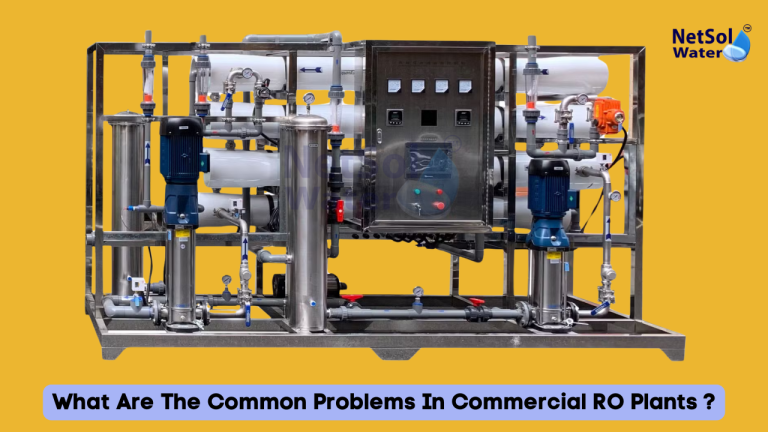
Commercial RO plants are a reliable solution for purifying large volumes of water for industries, hotels, hospitals, schools, and others. Even though these systems are highly efficient, they are not free from operational drawbacks. The well-maintained systems may, after some time, develop some issues that hinder their performance. It is essential to know the common problems in commercial RO plants and how to fix them to ensure constant operation and long-term efficiency.
In this blog, we will highlight the main issues that often occur in commercial RO plants and provide simple, practical solutions to allow you to fix them.
Common Problems in Commercial RO Plants
1) Membrane Fouling
Problem:
Membrane fouling is a most common problem in industrial RO plants. It is the phenomenon in which unwanted materials such as dirt, bacteria, minerals, and organic compounds stick to the membrane surface. It reduces the filtration rate of water and leads to low water production or poor quality water.
Solution:
Regular cleaning of the membrane using approved cleaning solutions is necessary. Use of pre-treatment technologies like sediment filters and antiscalants can further prevent fouling. Feedwater quality monitoring and regular cleaning per schedule are a must to ensure the health of the membrane.
2) Scaling
Problem:
Scaling occurs where dissolved salts like calcium and magnesium precipitate onto the membrane and form hard deposits. This is another common problem in commercial RO plants, especially where the water is hard. Scaling has the potential to destroy the membrane and reduce the life of the membrane.
Solution:
The use of antiscalant chemicals may inhibit scale precipitation. Pre-treatment with the use of water softeners or dosing systems can also reduce the risk of scaling. In the case where scaling has already occurred, the membrane has to be descaled with a descaling solution.
3) High TDS in Product Water
Problem:
When the dissolved solids (TDS) in the output water are higher than expected, then the RO system is not working properly. It can be due to membrane failure, bypassing of untreated water, or fault in the RO module.
Solutions:
Inspect the RO membranes for wear and tear, and replace them whenever necessary. Ensure all loose connections and leaks that might cause untreated water to mix with purified water are addressed. Monitoring and maintenance are the cause of keeping TDS levels within limits.
4) Low Water Pressure
Problem:
Low pressure on the feedwater line can significantly affect the operation of an RO plant. With low pressure, water does not pass through the membrane efficiently, resulting in reduced output and reduced rates of purification.
Solution:
Ensure the booster pump is functioning properly. Inspect filters or feedwater lines for any blockages that reduce pressure. Regular filter replacement and routine maintenance can keep pressure at optimum levels.
5) Pump or Motor Failure
Problem:
Pump and motor faults are also common problems in commercial RO plants. Due to wear and tear, overheating, or electrical faults after some time, malfunctioning or breakdown of the pumps may result.
Solution:
Regular inspection of pumps and motors is necessary. Lubricate and keep them timely. Electrical wiring should be checked for loose connections or short circuits. Replacement of aged components in good time will avoid catastrophic failure.
6) Excessive Wastewater
Problem:
Some RO plants produce excess wastewater than necessary, leading to water wastage and higher operational costs. This is usually due to incorrect system settings or faulty membranes.
Solution:
Adjust the recovery ratio of the RO plant to reduce wastewater production. Make sure that the system settings are as specified by the manufacturer. Replace old or inefficient membranes to increase efficiency.
7) Noise and Vibration
Problem:
Abnormal vibration or noise during operation is generally underemphasized but may be indicative of mechanical problems. It may result from pump imbalance, loose parts, or air in the system.
Solution:
Analyze the reason for the noise as soon as possible. Check all the fittings, pumps, and brackets. Air release valves may eliminate trapped air. Tightening of connections and replacing of damaged items can fix the issue.
8) Frequent System Shutdowns
Problem:
Some RO plants shut down too frequently due to electrical issues, malfunctioning sensors, or automation setting errors. Such repeated problems in commercial RO plants can interfere with routine operation and cause downtime.
Solution:
Control panel and sensor inspection is needed regularly. Float switches and automatic shut-down mechanisms have to be functioning. Electrical elements should be examined by a qualified technician to prevent repeated shutdowns.
Conclusion
Every RO plant is built to work efficiently under normal conditions, but even the most efficient system may face some issues at times. Understanding the most common problems in commercial RO plants and how to fix them is essential for trouble-free and uninterrupted operation. Regular maintenance, immediate inspections, and preventive maintenance can work wonders in adding years to the life of your commercial RO plant.
By recognizing the root causes of these common issues, businesses can reduce downtime, save capital, and continue to enjoy a consistent supply of quality water.
Do you need an advice or assistance on selecting the best water and waste water treatment unit? We have solutions for all your problems!
Let us know your problem, our experts will make sure that it goes away.
For an assistance or related query,
Call on +91-9650608473
Or write us at enquiry@netsolwater.com
